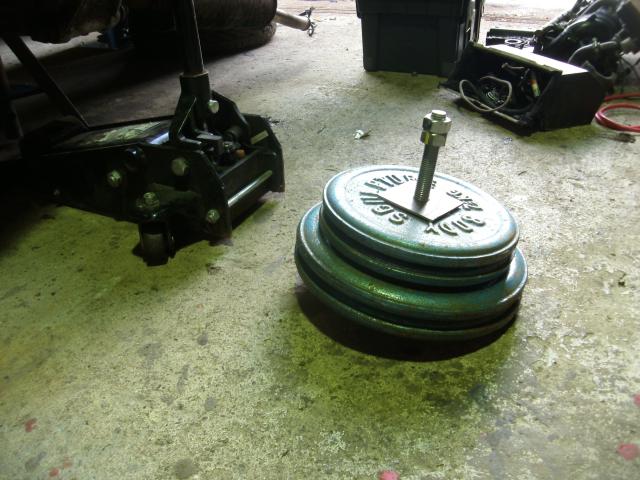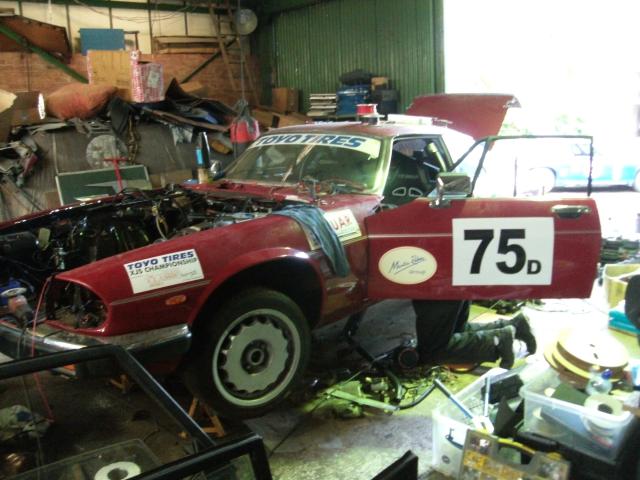GREGORY'S GIRL


Part 1: assessment and dismantly.
It was been taken to bits, but how many bits, which bits does it need, and are there any more we can take off? There is no point mincing about. It was what you might call a struggle to get it into the garage, this is a full-weight roadgoing class XJS with no engine, up a wet ramp, but we use a Bear for such lugging, and he’s the one who reversed a lorry over the tub of fibreglass resin that we’re having to avoid, so it’s only fair.
As the car coasts to a halt, it coughs the engine out of the front. They do that. To be fair, with no radiator hoses, and the cross bars neatly tie-wrapped to the panel, no engine loom etc, it wasn’t much more difficult than that.
A look at the car suggests that someone has OCD, and a party bag of multi-coloured tie-wraps. I have never seen so many tie-wraps used. I like tie-wraps, but there is a limit. A more careful look, and these have been used in a colour-coded and deliberate way. I don’t know whether to marvel or despair. It’s something special, whichever way you look at it.
The car has had some of the wiring taken out, and some more put in. That which has been put in appears to be heavier than what came out. Simpler, but chunky, and there are a thousand relays. Someone has been to huge effort. Which is a shame, because I took it all out, finding the world’s largest collection of P clips and self-tappers. Nothing wrong with any of it, just not how we do things.
Part of the cage has been taken out to get the dash out. The heater has been yanked. As have the blowers and part of the steering column. That bit’s easy, we have a tried and tested answer to that.
Unloaded, immobile, and heavy as chuff.
The exhaust is fitted, and is factory standard, complete with all four silencers. Two can be deleted. Inboard brakes, but they were new in ’09 and have done about a hundred miles so ought to be in good order. Camber looks a bit odd and will need checking.
The simplest thing to do then is to remove everything that is clearly not needed, and then reassess. Whilst I’m doing that, the Bear has the sump off the engine, and is licking the bearings to check them for wear. It’s something like that. Whilst basically in acceptable order at the bottom end, the engine has as much compression as an elderly asthmatic sloth, the rings likely more worn than a pornstar’s. It will run probably quite nicely, but it won’t pull a boy scout off your grandmother.
Will it get the boy back on track? Yes. That’s all he wants to achieve. It will also give a wonderful, wistful excuse – if I only had a bit more power… So that’s that, it’s going in as it is.
It's been in the garage about forty seconds....
It is a strange collection of bits though, we’re not used to seeing XJS 4 litre 16s, and its ancillaries, huge, thick pulleys and V belts, are alien to those who run X300 type stuff, but the brief was not to upgrade it all, just to make it work. We have to keep reminding ourselves. It is difficult, when everything you see or touch comes with a “and we modify this by…” mental label applied to it.
Steel plates that close various bulkheads, tunnel and firewalls are all taken off. Some have holes in and pipes passed through, siliconed up. Perfectly fine, but now that heater’s gone, we can move a few things about to make it neater and simpler. And with aluminium. Weight saving should never be passed up.
With that in mind, John’s portable gymnasium is removed from the car. In 2010 the class weight limit was 1580kg – which I claim is my fault, sorry folks – and this car, this most standard of cars, has 35 kg of John’s dumbbells behind the passenger seat. It puts the insanity of those old regs into perspective.
The doors are fully furnished. Briefly. There is no excuse for leaving central locking solenoids in, wiring that it doesn’t need, or locking mechanisms that might actually lock themselves. It is not lengthy work to remove and permanently disable them, the locks firmly tie-wrapped open evermore. It is a safety consideration after all. Has a car ever locked itself in a crash? We don’t intend to find out.
The boot is largely stripped already, we pause only to remove the wiring, take out the spare wheel carrier, and relocate the battery there. The swirl pot has to be re-anchored, but that is only a matter of a piece of alloy, making a bracket and four bolts. As we’ll run the cable through the car, the battery cable will now move too, as will the earth, but it is very swift work to sort the rear end once the mass of wiring has been removed.
We shall bore you only briefly, gentle listener, with tales of the parts removed, save to say that there was a further pile accumulated. You don’t need a horn or screen wash, for example, so they come out. Sound insulation that was hidden before can be heat-gunned out, things just generally go missing. The beauty to this car, for us, is that it’s a very pure project. Take bits off, replace parts as needed, but it will still be an XJS that’s had a diet. What we’re going for is for it to work, and to keep on working, not blisteringly quick, but not one that will break down all the time. There will be a vast list of “we could have”s and a long list of “We’d like to” but the brief isn’t that. It’s to get it back in the paddock.
A David arrives. He is going to rewire the car. Again, a pure and simple brief, make it work, reliably, erase the Jaguar foibles, fit accurate instruments and warning lights. I foresee a lot of aluminium cutting in my future.
With the car pared down to a sensible starting point, it can go together again. Bear has reassembled the engine. This time he fitted a flywheel and clutch before the gearbox, which will make it harder to rev but should improve drive. The engine gets largely dressed off the car, new oil pressure sender, water pump and rail, wiring, starter, alternator etc. It’s a couple of days before we throw it in the hole.
Before then, there is wiring to do. Easier to pass the new loom through bulkheads with no engine in the way. The extinguisher tubing is resited, and the ecu vacuum line is replaced. That line runs in cunifer through the car, but its turn to go up through the bulkhead was done rather enthusiastically, and the pipe is kinked almost shut. It obviously still worked, but worth attention, so the pipe is cut, and a longer length of silicone vacuum tube takes over. The thick walled stuff, not that thin rubbish.
The meagre ribbon of wire threads through the car over the course of 5 days. Whilst this is happening, there is that loud thing to go in the front. Now reassembled and dressed, it is time to stick it in the hole. It is hardly an unknown process here, and she is quickly posted in, prop connected, gearbox crossmember fitted. All new hoses for the engine. There is nothing wrong with Jaguar hoses, for the most part, but if you’re going to buy new hoses, there is not a great difference in cost to upgrade to silicone. The main hose which feeds the water rail, the bypass hose, and the long run which links water pump to heater, are all replaced in silicone.
The latter is done because we are, in fact, losing the heater altogether, so it goes straight in the back of the head. We don’t want the take offs to heat the inlet manifold either, so the original metal rail becomes pointless, hence the replacement.
The top and bottom hose, however, are a straight swap for new Jaguar hoses. You can get to them easily to check and replace them, so why spend more to make them? We do, because we use a non-standard radiator, but he doesn’t so he doesn’t have to.
The oil cooler doesn’t fit. It fits the car, and the hoses fit the engine, but the hoses don’t fit the cooler. We’ve met this problem before, and end up having bespoke hoses made, but John thinks he has the adaptor at home. For now it is therefore bypassed with a cooler bypass donut we have lying about the place.
Exhaust is an issue. The car was an AJ6, now a 16. We have spare manifolds to fit it for now, so these are chucked on until either he buys himself a set, or he goes down our top-secret alternate route that we can’t possibly tell you about here. The exhaust still has its central silencers, which are removed and replaced with bypass pipes left over from one of our old cars. It’s good to see some of the old parts find a home.
Inlet manifold on, deleting some of the pointless frippery. That in turn meant changing the extra air inlet tube. A lot of this is about trying to anticipate and fix problems we have had before, before they happen to him.
The throttle was very sticky, and was dismantled to free it off. Refitted, and the air intake gets minor attention. We chopped a hole in the headlight pod before the engine jumped in, the classic place to get your fresh air from. Even with a full headlight in there, you get plenty of air from around it, and it’s not been heated by the radiator. The car currently has a standard XJS airbox with the lid missing. Putting a lid back on with the front sawn off will allow it to be ducted to the hole we cut. We’re not doing that part, but we have adapted the car so that the owner can do it later, because you try cutting that hole with the engine in! The original filter is swapped for one not clogged with oil.
Not a bad first few days, but to hit the deadline we set ourselves, we’re going to have to up the pace a little here…









Stripdown. The pile of junk under the car, erm, "fell" out.
We'll be giving this back to John. He'll need them, we've taken the power steering off.
High tech table allows the Bear to reassemble the now-fondled engine.
Re-sited battery carrier is swift but useful work. De-bunged vertical panel probably does little, but just in case...
Remade panels, holes rivetted shut, the bulkhead is now a little more fireproof than before. Most Jags have holes here that nobody ever spots.
I don't know what's pulling him in, but something's got Officer David.
New hoses and gaskets give the engine a fighting chance.